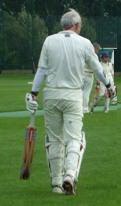 |
| SCG - Members' and Ladies' Stands |
She observed the changing rooms and the honours boards, the classic lines of the Members' and Ladies' Stands tranquil against the newer stands that now surround the field.
As she followed the tour guide onto the field of play she stroked the nose of the relief bust of Bradman - as all who pass through that gate do. Just as countless batsman have made a wish - for a century perhaps or at least that they are not out for a duck - she may have uttered a silent prayer.
It is too early in the season to know whether FB's wish is going to come true, although a betting man would not stake much on it. But the fates seemed to deliver for Mrs FB. For as FB languished in a New Zealand hotel room a week later he was advised, 'I've arranged a visit to the Cambridge Stud tomorrow. You don't have to come.'
'The Cambridge Stud? Who is he?'
'Don't be daft -it's not a person.'
'Oh,' said FB, the image of a lothario with a First in Greats receding.
 |
| Mrs FB beside Sir Tristram |
All that does not mean much to FB who does not follow horse racing or bloodstock breeding. He assumes that there may be some among his handful of worldwide readers who are familiar with such matters and will be nodding nod wisely at such information and be listing each and every of Sir Tristram's progeny.
It was not the breeding season at the time of FB's visit. So there was no stallion on mare action to divert them. This may have been a relief. For FB and Mrs FB were treated to more than graphic descriptions of the process, which when it comes down to it all seems a bit of a bother. And more than a bit dangerous too - not only for the mare.
For Sir Tristram appears to have been, how can FB put it, very difficult. Sir Tristram may have had speed genes; he may have been a noble beautiful animal, but he could hardly be said to have a winning personality. Perhaps it was just too much sex. Perhaps it was performance anxiety. It would after all do anyone in to have to perform 3 times a day, day in day out, even if an extra carrot was in prospect at the end of it.
For this is the regime at the height of the season. It brought out the nasty in Sir Tristram - he was all macho assertion. The guide told several tales of how difficult he was to catch at the start of the day - it generally took 3 stable lads to get hold of him in his paddock. He regularly attacked them - in one instance biting the shoulder of a handler and lifting him clear off the ground. One kick from him was bad news.
Exactly what all the mares saw in him is anyone's guess.


chris jordan stats
ReplyDeletechris jordan ipl
chris jordan wife
chris jordan age
chris jordan height
chris jordan instagram
chris jordan facebook
chris jordan twitter
chris jordan youtuber
chris jordan characteristics
chris jordan biography
chris jordan
chris jordan karachi kings